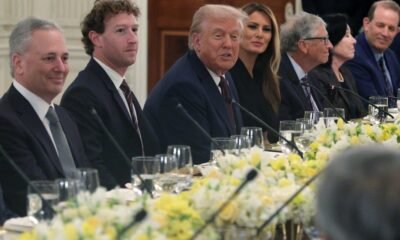Top Stories
UK and France agree to send some migrants arriving in Britain by boat back to France
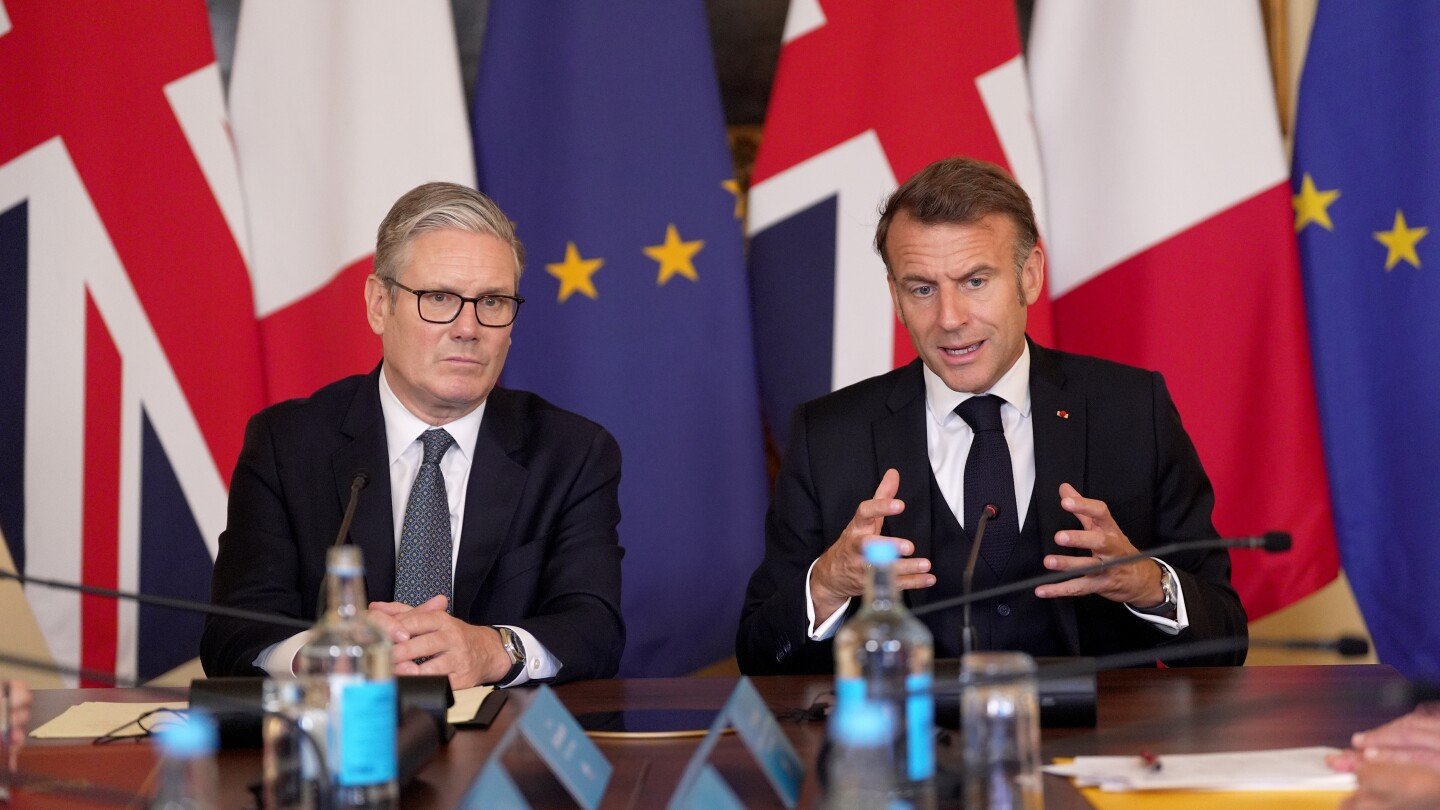
LONDON (AP) — Britain and France agreed Thursday to a pilot plan that will send some migrants who cross the English Channel on small boats back to France as the U.K. government struggles to tamp down criticism that it has lost control of the country’s borders.
U.K. Prime Minister Keir Starmer and French President Emmanuel Macron announced the deal Thursday in London. While the initial program a limited number of people, U.K. officials suggest it is a major breakthrough because it sets a precedent that migrants who reach Britain illegally can be returned to France.
“There is no silver bullet here, but with a united effort, new tactics and a new level of intent, we can finally turn the tables,’’ Starmer told reporters at a news conference. “For the very first time, migrants arriving via small boat will be detained and returned to France in short order.”
Under the agreement, Britain will send some of those who cross the Channel in small boats back to France while accepting an equal number migrants who are judged to have legitimate claims to asylum in the U.K.
Starmer had pushed for the arrangement, known as the “one in, one out” deal, in hopes of discouraging people from making the dangerous crossing. It is set to begin in weeks.
Small boat crossings have become a potent political issue in Britain, fueled by pictures of smugglers piling migrants into overcrowded, l eaky inflatable boats on the French coast. So far this year, more than 21,000 people have arrived in the UK in small boats, up 56% from the same period last year.
The crossing is dangerous and many have died.
“I’m totally committed to make it work, because this is clearly our willingness and our common interest,” Macron said. He added that the point of the pilot was a “deterrence” effect.
The measure announced Thursday is part of broader efforts to build closer cooperation with France, as well as countries further up the migrants’ routes from Africa and the Middle East.
British officials have been pushing for French police to intervene more forcefully to stop boats once they have left the shore, and welcomed the sight of officers slashing rubber dinghies with knives in recent days.
Macron said earlier this week that he and Starmer would aim for “tangible results” on an issue that’s “a burden for our two countries.”
An issue that has dogged relations between France and that U.K.
As far back as 2001, the two countries were discussing ways to stop the flow of migrants, though at that time they were focused on people stowing away on trains and trucks entering Britain through the tunnel under the channel.
Over the following years, French authorities cleared out camps near Calais where thousands of migrants gathered before trying to reach Britain. Beefed up security sharply reduced the number of vehicle stowaways, but from about 2018 people-smugglers began offering migrants a new route by sea.
“You see that pattern again and again, where smuggling gangs and migrants try to find new ways to cross from France to the U.K.,” said Mihnea Cuibus, a researcher at the University of Oxford’s Migration Observatory. “The authorities crack down on that, and then gradually you see migrants and gangs try to adapt to that. And it becomes a bit of a game of cat and mouse.”
Cooperation on stopping the boats stalled after Britain’s acrimonious split from the European Union in 2020, but in the past few years the countries have struck several agreements that saw the U.K. pay France to increase police and drone patrols of the coast.
Britain’s previous Conservative government came up with a contentious plan in 2022 to deport asylum-seekers arriving by boat to Rwanda. Critics called it unworkable and unethical, and it was scrapped by Starmer soon after he took office in July 2024.
Cuibus said irregular cross-channel migration would likely always be a challenge, but that the measures being discussed by Britain and France could make an impact, “if they’re implemented in the right way.
“But that’s a big if,” he said.
Summit yields deals on defense cooperation plans
The UK-France summit came after a three-day state visit that stressed the longstanding ties between the two countries despite the rupture caused by Britain’s departure from the European Union. Punctuated by carriage rides, banquets and champagne toasts, the two leaders hugged and offered a picture of unity — a step forward to greater cooperation in the future.
The bonhomie was followed by concrete actions. The two leaders sealed deals on defense cooperation, including a pledge to coordinate their nuclear deterrents for the first time.
“Now as Europe’s only nuclear powers and as leaders in NATO, we play a vital role in preserving the peace and security on this continent,” Starmer said.
“From today, our adversaries will know that any extreme threat to this continent would prompt a response from our two nations,” Starmer added.
Progress made on assisting Ukraine
Also Thursday Macron and Starmer visited a military base and dialed in to a planning meeting of the “ coalition of the willing, ” a U.K.- and France-initiated plan for an international force to guarantee a future ceasefire in Ukraine.
Americans attended the meeting for the first time, including retired Lt. Gen. Keith Kellogg, U.S. President Donald Trump’s special envoy to Ukraine and Russia. Republican Sen. Lindsey Graham and Democratic Sen. Richard Blumenthal, who have co-sponsored a new sanctions bill against Russia, were also at the table.
The group agreed to set up its headquarters in Paris to facilitate a rapid deployment after the war ends.
___
Associated Press Writer Brian Melley contributed.
Top Stories
South Korea says detained Korean workers released from Georgia facility before flight home
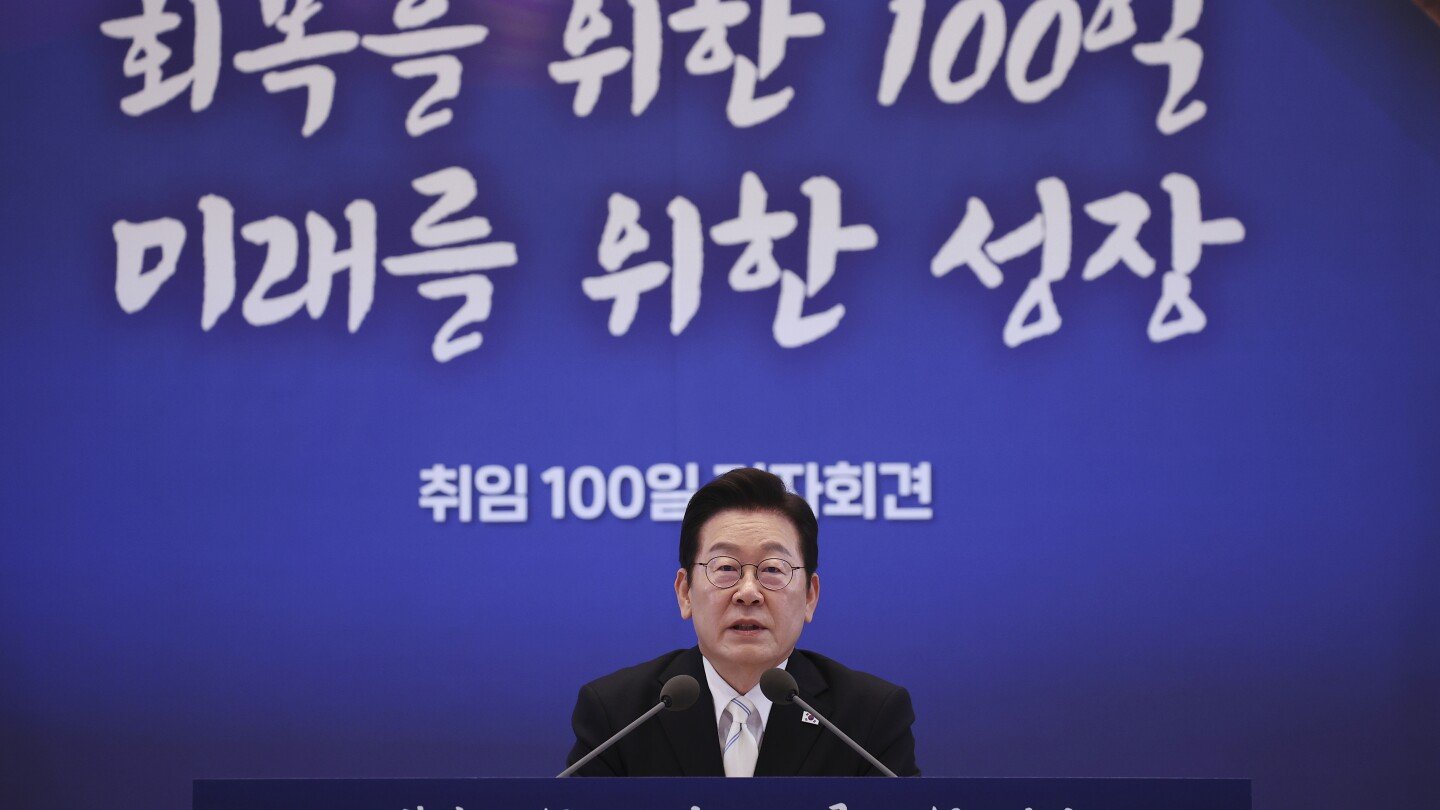
SEOUL, South Korea (AP) — South Korea’s president said Thursday that Korean companies will likely hesitate to make further investments in the United States unless Washington improves its visa system for their employees, as U.S. authorities released hundreds of workers who were detained from a Georgia factory site last week.
In a news conference marking 100 days in office, Lee Jae Myung called for improvements in the U.S. visa system as he spoke about the Sept. 4 immigration raid that resulted in the arrest of more than 300 South Korean workers at a battery factory under construction at Hyundai’s sprawling auto plant west of Savannah.
South Korea’s Foreign Ministry later confirmed that U.S. authorities have released the 330 detainees – 316 of them Koreans – and that they were being transported by buses to Atlanta’s Hartsfield-Jackson airport where they will board a charter flight scheduled to arrive in South Korea on Friday afternoon. The group also includes 10 Chinese nationals, three Japanese nationals and one Indonesian.
The massive roundup and U.S. authorities’ release of video showing some workers being chained and taken away, sparked widespread anger and a sense of betrayal in South Korea. The raid came less than two weeks after a summit between U.S. President Donald Trump and Lee, and just weeks after the countries reached a July agreement that spared South Korea from the Trump administration’s highest tariffs — but only after Seoul pledged $350 billion in new U.S. investments, against the backdrop of a decaying job market at home.
Lawmakers from both Lee’s liberal Democratic Party and the conservative opposition decried the detentions as outrageous and heavy-handed, while South Korea’s biggest newspaper compared the raid to a “rabbit hunt” executed by U.S. immigration authorities in a zeal to meet an alleged White House goal of 3,000 arrests a day.
During the news conference, Lee said South Korean and U.S. officials are discussing a possible improvement to the U.S. visa system, adding that under the current system South Korean companies “can’t help hesitating a lot” about making direct investments in the U.S.
Lee: ‘It’s not like these are long-term workers’
U.S. authorities said some of the detained workers had illegally crossed the U.S. border, while others entered legally but had expired visas or entered on visa waivers that prohibited them from working.
But South Korean officials expressed frustration that Washington has yet to act on Seoul’s yearslong demand to ensure a visa system to accommodate skilled Korean workers, though it has been pressing South Korea to expand U.S. industrial investments.
South Korean companies have been mostly relying on short-term visitor visas or Electronic System for Travel Authorization to send workers who are needed to launch manufacturing sites and handle other setup tasks, a practice that had been largely tolerated for years.
Lee said that whether Washington establishes a visa system allowing South Korean companies to send skilled workers to industrial sites will have a “major impact” on future South Korean investments in America.
“It’s not like these are long-term workers. When you build a factory or install equipment at a factory, you need technicians, but the United States doesn’t have that workforce and yet they won’t issue visas to let our people stay and do the work,” he said.
“If that’s not possible, then establishing a local factory in the United States will either come with severe disadvantages or become very difficult for our companies. They will wonder whether they should even do it,” Lee added.
Lee said the raid showed a “cultural difference” between the two countries in how they handle immigration issues.
“In South Korea, we see Americans coming on tourist visas to teach English at private cram schools — they do it all the time, and we don’t think much of it, it’s just something you accept,” Lee said.
“But the United States clearly doesn’t see things that way. On top of that, U.S. immigration authorities pledge to strictly forbid illegal immigration and employment and carry out deportations in various aggressive ways, and our people happened to be caught in one of those cases,” he added.
South Korea, US agree on working group to settle visa issues
Following a meeting with U.S. Secretary of State Marco Rubio in Washington, South Korean Foreign Minister Cho Hyun said Wednesday that U.S. officials have agreed to allow the workers detained in Georgia to later return to finish their work at the site. He added that the countries agreed to set up a joint working group for discussions on creating a new visa category to make it easier for South Korean companies to send their staff to work in the United States.
Before leaving for the U.S. on Monday, Cho said more South Korean workers in the U.S. could be vulnerable to future crackdowns if the visa issue isn’t resolved, but said Seoul does not yet have an estimate of how many might be at risk.
The Georgia battery plant is one of more than 20 major industrial sites that South Korean companies are currently building in the United States. They include other battery factories in Georgia and several other states, a semiconductor plant in Texas, and a shipbuilding project in Philadelphia, a sector Trump has frequently highlighted in relation to South Korea.
Min Jeonghun, a professor at South Korea’s National Diplomatic Academy, said it’s chiefly up to the United States to resolve the issue, either through legislation or by taking administrative steps to expand short-term work visas for training purposes.
Without an update in U.S. visa policies, Min said, “Korean companies will no longer be able to send their workers to the United States, causing inevitable delays in the expansion of facilities and other production activities, and the harm will boomerang back to the U.S. economy.”
Top Stories
Poland shoots down Russian drones: Will NATO enter war in Ukraine? | Russia-Ukraine war News
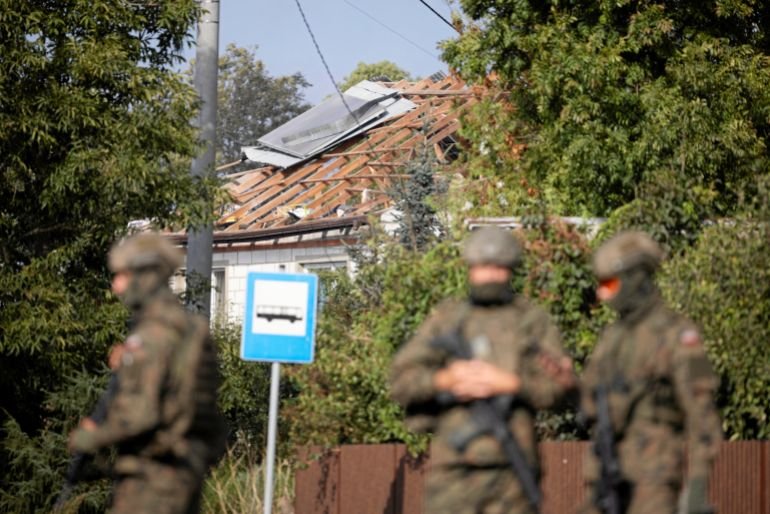
Polish and NATO forces scrambled to intercept Russian drones which entered Poland’s airspace early on Tuesday night and early on Wednesday, marking their first direct military engagement with Moscow since the Kremlin’s full-scale invasion of Ukraine began in 2022.
Both Polish and NATO jets responded to the violation of Polish airspace, which occurred during a Russian aerial attack on Ukraine. “There was an unprecedented violation of Polish airspace by drone-type objects,” the Polish military operational command said in a statement. “This is an act of aggression that posed a real threat to the safety of our citizens.”
Poland temporarily shut down at least three of its airports, including Warsaw’s Chopin Airport, the country’s largest, and advised people to stay at home while the operation continues. People in risk-prone areas in eastern regions of Poland bordering Ukraine, including the capital of Warsaw, have been told to take shelter.
“There is no reason to claim that we are in a state of war… but the situation is significantly more dangerous than all previous ones,” said Polish Prime Minister Donald Tusk. He added that the prospect of a large military conflict is “closer than at any time since the Second World War”.
The Russian drone incursion comes just three days after Moscow hit the main government building in Ukraine’s Kyiv. That attack also damaged the European Union and British Council buildings in the Ukrainian capital.
So, is NATO now inching towards a war with Russia?
What has happened in Poland?
On Wednesday morning, the Polish military said it had shot down “drone-like objects” which entered its airspace during a Russian aerial attack on neighbouring Ukraine.
According to Polish officials, the drones crossed the border amid a wave of Russian aerial strikes targeting western Ukraine, triggering an immediate military response, which was joined by Polish F-16 fighter jets, Dutch F-35, and Italian AWACS surveillance planes.
One of the drones struck a residential building in Wyryki, eastern Poland. Nobody was injured, according to the Reuters news agency.
This is the first time that NATO-allied forces have engaged Russian military assets since Moscow invaded Ukraine in February 2022.
Tusk called Russia’s violation of Polish airspace by a “huge” number of Russian drones a “large-scale provocation”. He added that the NATO forces had shot down the ones that posed any threat.
Later in the day, Tusk informed Poland’s parliament that the first violation of Polish airspace occurred at about 11:30pm (21:30 GMT) on Tuesday, and the last was reported at 6:30am (04:30 GMT) on Wednesday.
He added that preliminary reports suggest there were 19 airspace violations in total, with a “significant number” of drones crossing into Poland.
“We are ready to repel such provocations. The situation is serious, and no one doubts that we must prepare for various scenarios,” Tusk said in his statement. “All our allies are taking the situation very seriously. We have not recorded any casualties.”
Tusk also convened an emergency meeting with his top cabinet ministers and stated that his office was in contact with NATO officials.
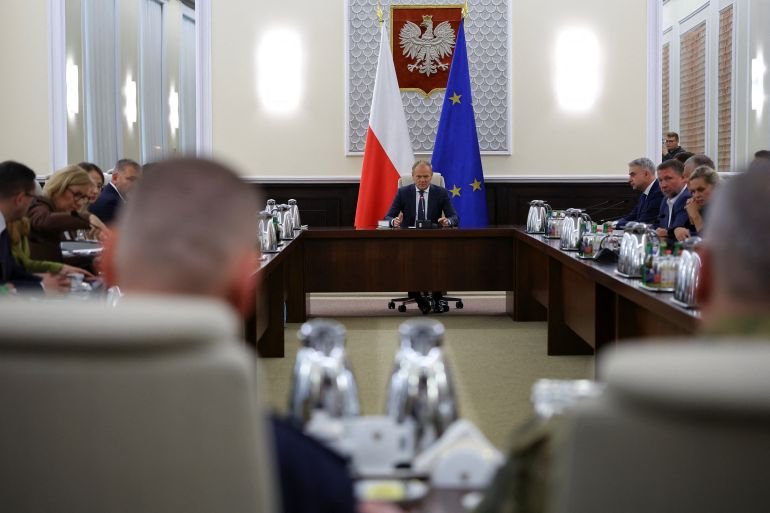
Could this drag NATO into Russia’s war in Ukraine?
The incident has thrust NATO’s collective defence principles into the spotlight. Being a NATO member, a drone attack on Poland could trigger Article 5 of the NATO treaty.
That article forms the cornerstone of the alliance’s collective defence strategy. It states that an “armed attack” against one or more members in Europe or North America shall be considered an attack against all, obligating allies to take action, including the use of armed force, to restore security.
Article 5 is not triggered automatically by such an attack, but can be initiated by an affected nation. It requires a consensus among NATO’s 30 member states that the incident meets the threshold of an attack warranting collective action.
Since the treaty was first signed in 1949, Article 5 has been invoked only once, following the September 11, 2001, attacks on the US.
Will Poland initiate Article 5?
Not quite yet. Tusk said Poland will invoke Article 4 of the treaty, under which a nation can request a formal consultation within the alliance if it believes its security has been threatened. This would serve as a political precursor to Article 5 deliberations.
Historically, Article 4 has been invoked only seven times since NATO’s creation; the last time was by Bulgaria, the Czech Republic, Estonia, Latvia, Lithuania, Poland, Romania and Slovakia in 2022 immediately after the Russian invasion of Ukraine.
While Tusk said he appreciates expressions of solidarity, “the words are not enough” and Poland will request “much greater” support from its allies.

How has the EU responded to this incident?
The EU’s top diplomat, Kaja Kallas, vice president of the European Commission, said the incident marked an escalation of Russia’s war in Ukraine.
“We must raise the cost on Moscow, strengthen support for Ukraine, and invest in Europe’s defence,” she said in a statement posted on X. “The EU plays a major role and we will support initiatives like the eastern border shield defence line.”
Kallas said the EU stood in “full solidarity with Poland” and called the Russian drone intrusion “the most serious European airspace violation by Russia since the war began, and indications suggest it was intentional, not accidental”.
EU’s defence commissioner, Andrius Kubilius, also emphasised the need for a “drone wall” along its shared borders. “Once again Russia tests frontier states, EU & NATO,” Kubilius wrote in a post on X. “We shall work together with member states, frontier countries and Ukraine. Russia will be stopped.”
How has Ukraine responded?
Ukraine’s president, Volodymyr Zelenskyy, warned that Moscow was continuing to “push the boundaries of what is possible” by aiming drones at Poland.
“If [Russia] does not encounter a strong reaction, it remains at the new level of escalation,” Zelenskyy said, adding that 15 regions of Ukraine had been targeted overnight in a “massive” attack by 415 drones of various types and more than 40 cruise and ballistic missiles.
“The Russians must feel the consequences. Russia must feel that the war cannot be expanded and will have to be ended,” said the Ukrainian president.
What else is Russia doing right now?
The violation of Polish airspace by the Russian drones comes as Moscow ramps up its attacks on Kyiv, stalls ceasefire talks and plans military exercises in neighbouring Belarus.
Poland said it would close its border with Belarus on Thursday, at midnight (22:00 GMT), in advance of an upcoming military drill.
Russia and Belarus’s large-scale military exercises, called the “Zapad” drills – meaning “west” in Russian – typically involve thousands of troops, tanks, aircraft and live-fire operations across western regions. The drill is a particular security concern for neighbouring NATO member states Poland, Lithuania and Latvia.
“On Friday, Russian-Belarusian manoeuvres, very aggressive from a military doctrine perspective, begin in Belarus, very close to the Polish border,” Tusk told a government meeting in Poland.
Belarus’s defence minister said this year’s Zapad would include drills for the possible use of nuclear weapons and the Russian-made, intermediate-range hypersonic Oreshnik missile.
Past Zapad drills have prompted concerns in the West, most notably in 2021, when Russian troops deployed in Belarus for exercises stayed for longer than expected and then spearheaded one part of the 2022 invasion of Ukraine.
India, which has been hit by United States President Donald Trump with additional trade tariffs for buying Russian oil, is also expected to join the seven-day military drill. Trump is now also pushing the EU to levy a 100 percent trade tariff on India – and has reportedly offered to match this if it agrees.
Despite sustained diplomatic engagement for months as well as pressure from the US, the gap between Moscow and Kyiv shows little sign of narrowing, particularly on issues such as territorial concessions and post-war security arrangements.
Top Stories
Conservative activist Charlie Kirk dead after being shot at Utah university event
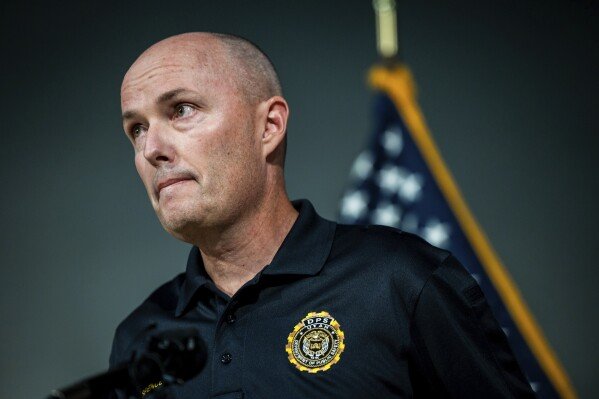
OREM, Utah (AP) — Charlie Kirk, a conservative activist and close ally of President Donald Trump who played an influential role in rallying young Republican voters, was shot and killed Wednesday at a Utah college event in what the governor called a political assassination carried out from a rooftop.
“This is a dark day for our state. It’s a tragic day for our nation,” said Utah Gov. Spencer Cox. “I want to be very clear this is a political assassination.”
No suspect was in custody late Wednesday, though authorities were searching for a new person of interest, according to a law enforcement official familiar with the matter who was not authorized to discuss the situation by name and spoke on condition of anonymity. Two people were detained earlier in the day but neither was determined to have had any connection to the shooting and both have been released, Utah public safety officials said.
Authorities did not immediately identify a motive but the circumstances of the shooting drew renewed attention to an escalating threat of political violence in the United States that in the last several years has cut across the ideological spectrum. The assassination drew bipartisan condemnation, but a national reckoning over ways to prevent political grievances from manifesting as deadly violence seemed elusive.
Videos posted to social media from Utah Valley University show Kirk speaking into a handheld microphone while sitting under a white tent emblazoned with the slogans “The American Comeback” and “Prove Me Wrong.” A single shot rings out and Kirk can be seen reaching up with his right hand as a large volume of blood gushes from the left side of his neck. Stunned spectators are heard gasping and screaming before people start to run away. The Associated Press was able to confirm the videos were taken at Sorensen Center courtyard on the Utah Valley University campus.
People were seen exiting a building on Utah Valley University after Charlie Kirk, the CEO and co-founder of the conservative youth organization Turning Point USA, was shot Wednesday at an event on campus.
Kirk was speaking at a debate hosted by his nonprofit political organization. Immediately before the shooting, Kirk was taking questions from an audience member about mass shootings and gun violence.
“Do you know how many transgender Americans have been mass shooters over the last 10 years?” the person asked. Kirk responded, “Too many.”
The questioner followed up: “Do you know how many mass shooters there have been in America over the last 10 years?”
“Counting or not counting gang violence?” Kirk asked.
Then a single shot rang out. The shooter, who Cox pledged would be held accountable in a state with the death penalty, wore dark clothing and fired from a building roof some distance away to the courtyard where the event took place.
Some 3,000 people were in attendance, according to a statement from the Utah Department of Public Safety, which also said the university police department had six officers working the event along with Kirk’s own security detail.
The death was announced on social media by Trump, who praised the 31-year-old Kirk, the co-founder and CEO of the youth organization Turning Point USA, as “Great, and even Legendary.” Later Wednesday, he released a recorded video from the White House in which he called Kirk a “martyr for truth and freedom” and blamed the rhetoric of the “radical left” for the killing.
AP AUDIO: Conservative activist Charlie Kirk in critical condition after being shot at Utah college event
AP correspondent Haya Panjwani reports on an attack on Charlie Kirk.
Utah Valley University said the campus was immediately evacuated and remained closed. Classes were canceled until further notice. Those still on campus were asked to stay in place until police officers could safely escort them off campus. Armed officers walked around the neighborhood bordering the campus, knocking on doors and asking for information on the shooter.
Officers were seen looking at a photo on their phones and showing it to people to see if they recognized a person of interest.
The event, billed as the first stop on Kirk’s “The American Comeback Tour,” had generated a polarizing campus reaction. An online petition calling for university administrators to bar Kirk from appearing received nearly 1,000 signatures. The university issued a statement last week citing First Amendment rights and affirming its “commitment to free speech, intellectual inquiry, and constructive dialogue.”
Last week, Kirk posted on X images of news clips showing his visit was sparking controversy. He wrote, “What’s going on in Utah?”
The shooting drew swift condemnation across the political aisle as Democratic officials joined Trump, who ordered flags lowered to half-staff and issued a presidential proclamation, and Republican allies of Kirk in decrying the violence.
“The attack on Charlie Kirk is disgusting, vile, and reprehensible,” Democratic California Gov. Gavin Newsom, who last March hosted Kirk on his podcast, posted on X.
“The murder of Charlie Kirk breaks my heart. My deepest sympathies are with his wife, two young children, and friends,” said Gabrielle Giffords, the former Democratic congresswoman who was wounded in a 2011 shooting in her Arizona district.
The shooting appeared poised to become part of a spike of political violence that has touched a range of ideologies and representatives of both major parties. The attacks include the assassination of a Minnesota state lawmaker and her husband at their house in June, the firebombing of a Colorado parade to demand Hamas release hostages, and a fire set at the house of Pennsylvania’s governor, who is Jewish, in April. The most notorious of these events is the shooting of Trump during a campaign rally last year.
Former Utah congressman Jason Chaffetz, a Republican who was at Wednesday’s event, said in an interview on Fox News Channel that he heard one shot and saw Kirk go back.
“It seemed like it was a close shot,” Chaffetz said, who seemed shaken as he spoke.
He said there was a light police presence at the event and Kirk had some security but not enough.
“Utah is one of the safest places on the planet,” he said. “And so we just don’t have these types of things.”
Turning Point was founded in suburban Chicago in 2012 by Kirk, then 18, and William Montgomery, a tea party activist, to proselytize on college campuses for low taxes and limited government. It was not an immediate success.
But Kirk’s zeal for confronting liberals in academia eventually won over an influential set of conservative financiers.
Despite early misgivings, Turning Point enthusiastically backed Trump after he clinched the GOP nomination in 2016. Kirk served as a personal aide to Donald Trump Jr., the president’s eldest son, during the general election campaign.
Soon, Kirk was a regular presence on cable TV, where he leaned into the culture wars and heaped praise on the then-president. Trump and his son were equally effusive and often spoke at Turning Point conferences.
__
Richer and Sherman reported from Washington. Associated Press writers Nicholas Riccardi in Denver and Michael Biesecker, Brian Slodysko, Lindsay Whitehurst and Michelle L. Price in Washington contributed to this report.
-

 Business2 weeks ago
Business2 weeks agoThe Guardian view on Trump and the Fed: independence is no substitute for accountability | Editorial
-
Tools & Platforms1 month ago
Building Trust in Military AI Starts with Opening the Black Box – War on the Rocks
-

 Ethics & Policy2 months ago
Ethics & Policy2 months agoSDAIA Supports Saudi Arabia’s Leadership in Shaping Global AI Ethics, Policy, and Research – وكالة الأنباء السعودية
-

 Events & Conferences4 months ago
Events & Conferences4 months agoJourney to 1000 models: Scaling Instagram’s recommendation system
-

 Jobs & Careers2 months ago
Jobs & Careers2 months agoMumbai-based Perplexity Alternative Has 60k+ Users Without Funding
-

 Podcasts & Talks2 months ago
Podcasts & Talks2 months agoHappy 4th of July! 🎆 Made with Veo 3 in Gemini
-

 Education2 months ago
Education2 months agoMacron says UK and France have duty to tackle illegal migration ‘with humanity, solidarity and firmness’ – UK politics live | Politics
-

 Education2 months ago
Education2 months agoVEX Robotics launches AI-powered classroom robotics system
-

 Funding & Business2 months ago
Funding & Business2 months agoKayak and Expedia race to build AI travel agents that turn social posts into itineraries
-

 Podcasts & Talks2 months ago
Podcasts & Talks2 months agoOpenAI 🤝 @teamganassi












